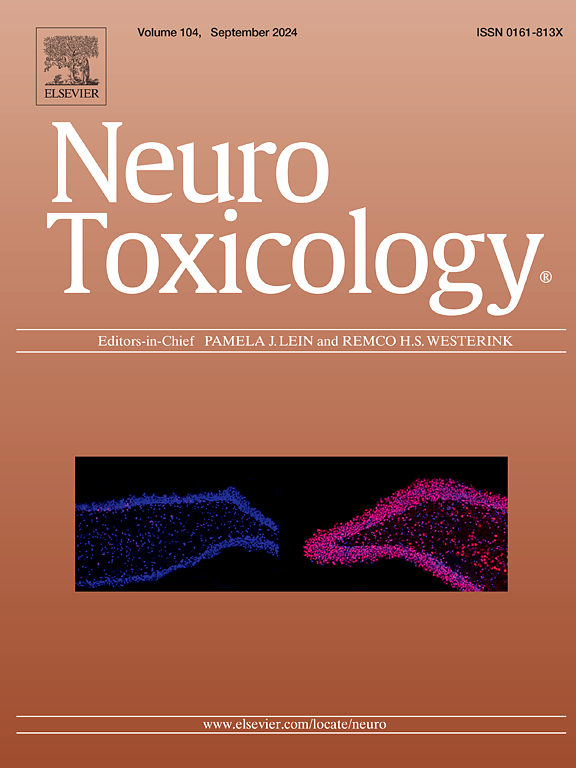Occupational aluminum exposure in northern China’s large-scale plants: Unveiling dual-pathway mediation of fasting blood glucose and systolic blood pressure in cognitive impairment among workers
IF 3.9
3区 医学
Q2 NEUROSCIENCES
引用次数: 0
Abstract
Introduction
The relationship between aluminium exposure and cognitive impairment remains to be fully elucidated. Furthermore, studies examining potential mediating mechanisms are limited. Objectives: The study investigated the relationship between plasma aluminium (P-Al) levels and cognitive impairment (was defined as a Montreal Cognitive Assessment (MoCA) score < 26 (i.e., mild cognitive impairment, MCI). The parallel mediating effects of systolic blood pressure (SBP) and fasting blood glucose (FBG) in the association between plasma aluminum (P-Al) and cognitive function were analyzed.
Methods
In this cross-sectional study of 229 aluminum workers (2024 survey), we conducted a three-step analysis:Descriptive statistics: Demographic and clinical variables were summarized as mean ± SD or median (IQR) for continuous data, and frequencies (%) for categorical data.Group comparisons: ANOVA with Bonferroni correction (normal-distributed variables) and Kruskal-Wallis H test were used to compare differences across P-Al quartiles (Q1 - Q4). Categorical variables were analyzed by χ² or Fisher’s exact tests.Mediation analysis: A dual-pathway mediation model (SBP and FBG as parallel mediators) was tested using bootstrap method. Effects were reported as standardized β coefficients with 95 % CIs.
Results
Workers in the high P-Al group had significantly lower MoCA scores (P < 0.05) and higher incidence of cognitive dysfunction (P < 0.05). P-Al levels were negatively correlated with MoCA scores (r = -0.716, P < 0.05) and indirectly affected cognitive function through the parallel mediating pathways of SBP (7.41 % of indirect effect) and FBG (18.52 % of indirect effect), with the direct effect accounting for 74.07 % of the total effect.
Conclusion
Aluminum exposure is significantly associated with cognitive impairment, which may have dual effects on metabolic disorders (elevated FBG) and vascular damage (elevated blood pressure) pathways.In order to reduce the risk of occupational cognitive dysfunction, it is necessary to implement enhanced P-Al monitoring and metabolic index interventions for aluminium workers.
中国北方大型工厂职业性铝暴露:揭示空腹血糖和收缩压在工人认知障碍中的双通路调解
铝暴露与认知障碍之间的关系仍有待充分阐明。此外,研究潜在的中介机制是有限的。目的:研究血浆铝(P-Al)水平与认知障碍(定义为蒙特利尔认知评估(MoCA)评分<; 26)(即轻度认知障碍,MCI)之间的关系。分析收缩压(SBP)和空腹血糖(FBG)在血浆铝(P-Al)与认知功能相关性中的平行中介作用。方法对229名铝厂工人(2024年调查)进行横断面研究,采用三步分析方法:描述性统计:连续数据以mean±SD或median (IQR)总结人口学和临床变量,分类数据以frequency(%)总结。组间比较:采用Bonferroni校正方差分析(正态分布变量)和Kruskal-Wallis H检验比较P-Al四分位数(Q1 - Q4)之间的差异。分类变量采用χ 2或Fisher精确检验进行分析。中介分析:采用自举法对双通路的中介模型(收收压和空腹血糖作为平行中介)进行检验。效果报告为标准化β系数为95% % ci。结果高磷铝组员工MoCA评分显著低于对照组(P <; 0.05),认知功能障碍发生率显著高于对照组(P <; 0.05)。P- al水平与MoCA评分呈负相关(r = -0.716,P <; 0.05),并通过平行介导的收缩压(间接效应的7.41 %)和空腹血糖(间接效应的18.52 %)间接影响认知功能,其中直接效应占总效应的74.07 %。结论铝暴露与认知功能障碍有显著相关性,认知功能障碍可能在代谢紊乱(空腹血糖升高)和血管损伤(血压升高)途径上具有双重作用。为了降低职业认知功能障碍的风险,有必要加强对铝工人的P-Al监测和代谢指标干预。
本文章由计算机程序翻译,如有差异,请以英文原文为准。
求助全文
约1分钟内获得全文
求助全文
来源期刊

Neurotoxicology
医学-毒理学
CiteScore
6.80
自引率
5.90%
发文量
161
审稿时长
70 days
期刊介绍:
NeuroToxicology specializes in publishing the best peer-reviewed original research papers dealing with the effects of toxic substances on the nervous system of humans and experimental animals of all ages. The Journal emphasizes papers dealing with the neurotoxic effects of environmentally significant chemical hazards, manufactured drugs and naturally occurring compounds.
 求助内容:
求助内容: 应助结果提醒方式:
应助结果提醒方式:


